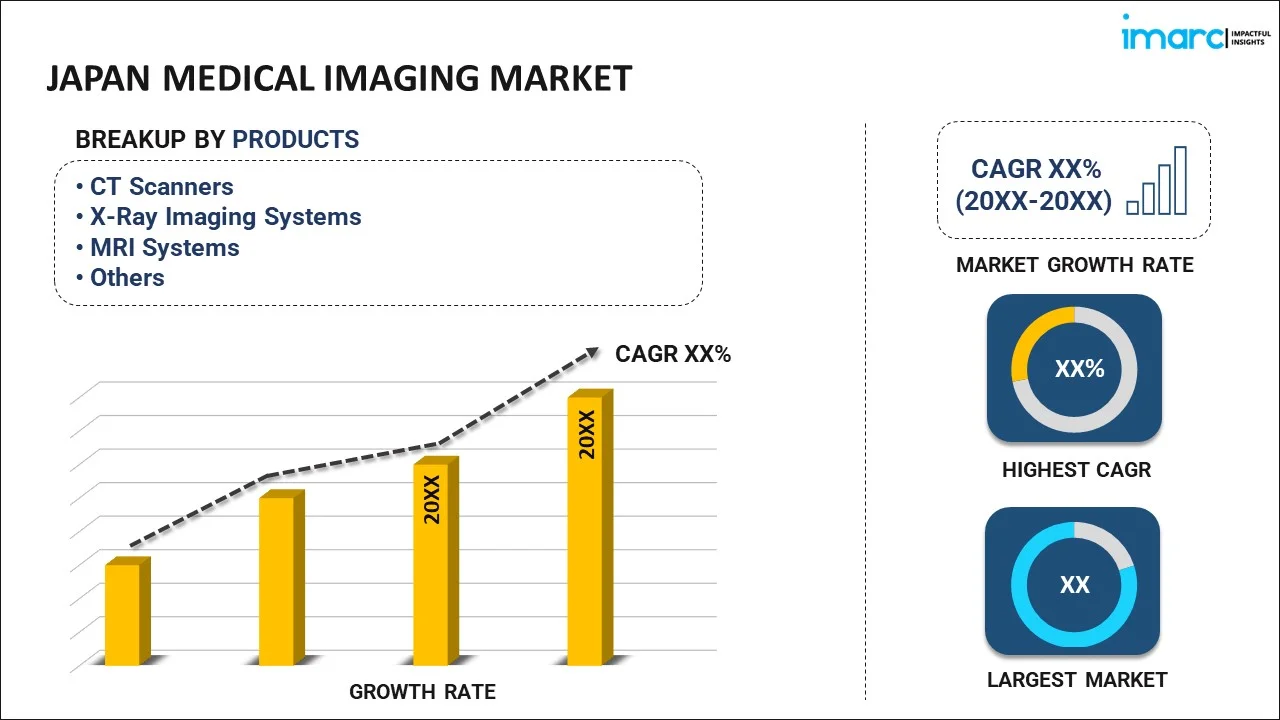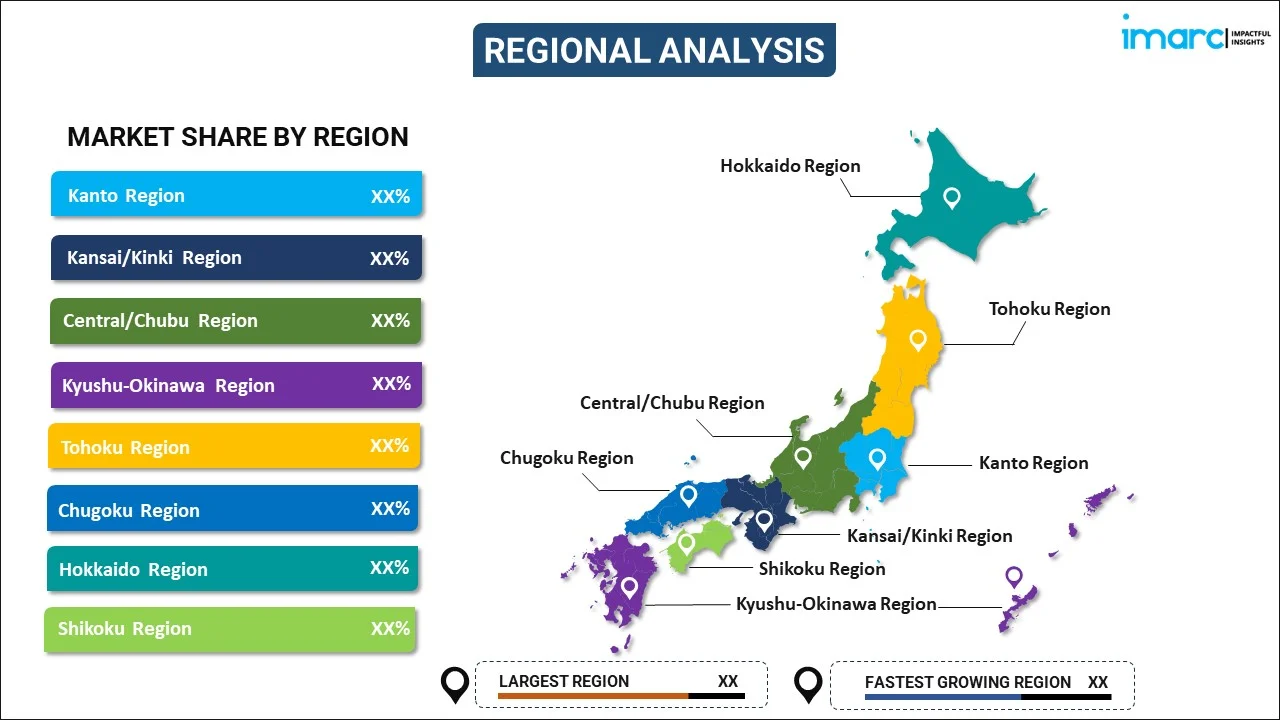
Japan Medical Imaging Market Report by Product (CT Scanners, X-Ray Imaging Systems, MRI Systems, Ultrasound Imaging Systems, Nuclear Imaging Systems, Mammography Systems), Application (Obstetrics and Gynecology Health, Orthopedics and Musculoskeletal, Neuro and Spine, Cardiovascular and Thoracic, General Imaging, Breast Health, and Others), End User (Hospitals, Diagnostic Centers, Academic Institutes and Research Organizations), and Region 2025-2033
Market Overview:
Japan medical imaging market size reached USD 1,793 Million in 2024. Looking forward, IMARC Group expects the market to reach USD 2,787 Million by 2033, exhibiting a growth rate (CAGR) of 5% during 2025-2033. The growing demand for various imaging modalities, including CT scans, MRI, and PET scans, as they play a crucial role in cancer diagnosis, staging, and treatment planning, is primarily driving the market growth.
|
Report Attribute
|
Key Statistics
|
|---|---|
|
Base Year
|
2024
|
|
Forecast Years
|
2025-2033
|
|
Historical Years
|
2019-2024
|
|
Market Size in 2024
|
USD 1,793 Million |
|
Market Forecast in 2033
|
USD 2,787 Million |
| Market Growth Rate 2025-2033 | 5% |
Medical imaging encompasses the methodology of generating visual representations of the human body to diagnose medical conditions and guide subsequent treatment. Common medical imaging modalities include computed tomography (CT) scanners, magnetic resonance imaging (MRI), nuclear imaging, mammography, and ultrasound. This non-invasive approach enables healthcare professionals to evaluate patients' bones, organs, tissues, and blood vessels. Medical imaging procedures are characterized by their safety, speed, and ease of execution, playing a crucial role in facilitating early and precise diagnoses, comprehension of medical complexities, and reducing the necessity for invasive exploratory surgeries. Consequently, medical imaging is widely applied in various medical specialties, including cardiovascular and thoracic medicine, orthopedics and musculoskeletal care, obstetrics and gynecology, as well as neurology.
Japan Medical Imaging Market Trends:
The healthcare industry's substantial expansion is generating a favorable outlook for the market, particularly in Japan. Additionally, the increasing prevalence of lifestyle-related diseases attributed to sedentary lifestyles and age-related conditions within the growing elderly population is further bolstering market growth. Medical imaging serves as a vital diagnostic tool across various healthcare specialties, aiding in the identification of conditions such as cancer, heart blockages, fractures, and tumors. Moreover, the introduction of advanced three-dimensional (3D) imaging technology, promising enhanced resolutions and intricate details, is propelling market growth by enhancing patient care. Furthermore, the incorporation of artificial intelligence (AI) into medical imaging is contributing to tissue-based detection improvements, ensuring accuracy and sensitivity in identifying imaging anomalies. In response to the COVID-19 pandemic, the heightened demand for CT scans and MRIs to assess lung conditions related to the virus is positively influencing market growth. Additional factors, including increased consumer spending capacity, extensive research and development (R&D) endeavors, and the introduction of portable imaging devices, are anticipated to drive market expansion in Japan over the forecasted period.
Japan Medical Imaging Market Segmentation:
IMARC Group provides an analysis of the key trends in each segment of the market, along with forecasts at the country level for 2025-2033. Our report has categorized the market based on product, application, and end user.
Product Insights:

- CT Scanners
- X-Ray Imaging Systems
- MRI Systems
- Ultrasound Imaging Systems
- Nuclear Imaging Systems
- Mammography Systems
The report has provided a detailed breakup and analysis of the market based on the product. This includes CT scanners, X-ray imaging systems, MRI systems, ultrasound imaging systems, nuclear imaging systems, and mammography systems.
Application Insights:
- Obstetrics and Gynecology Health
- Orthopedics and Musculoskeletal
- Neuro and Spine
- Cardiovascular and Thoracic
- General Imaging
- Breast Health
- Others
A detailed breakup and analysis of the market based on the application have also been provided in the report. This includes obstetrics and gynecology health, orthopedics and musculoskeletal, neuro and spine, cardiovascular and thoracic, general imaging, breast health, and others.
End User Insights:
- Hospitals
- Diagnostic Centers
- Academic Institutes and Research Organizations
The report has provided a detailed breakup and analysis of the market based on the end user. This includes hospitals, diagnostic centers, and academic institutes and research organizations.
Regional Insights:

- Kanto Region
- Kansai/Kinki Region
- Central/ Chubu Region
- Kyushu-Okinawa Region
- Tohoku Region
- Chugoku Region
- Hokkaido Region
- Shikoku Region
The report has also provided a comprehensive analysis of all the major regional markets, which include Kanto Region, Kansai/Kinki Region, Central/ Chubu Region, Kyushu-Okinawa Region, Tohoku Region, Chugoku Region, Hokkaido Region, and Shikoku Region.
Competitive Landscape:
The market research report has also provided a comprehensive analysis of the competitive landscape. Competitive analysis such as market structure, key player positioning, top winning strategies, competitive dashboard, and company evaluation quadrant has been covered in the report. Also, detailed profiles of all major companies have been provided.
Japan Medical Imaging Market Report Coverage:
| Report Features | Details |
|---|---|
| Base Year of the Analysis | 2024 |
| Historical Period | 2019-2024 |
| Forecast Period | 2025-2033 |
| Units | Million USD |
| Scope of the Report | Exploration of Historical and Forecast Trends, Industry Catalysts and Challenges, Segment-Wise Historical and Predictive Market Assessment:
|
| Products Covered | CT Scanners, X-Ray Imaging Systems, MRI Systems, Ultrasound Imaging Systems, Nuclear Imaging Systems, Mammography Systems |
| Applications Covered | Obstetrics and Gynecology Health, Orthopedics and Musculoskeletal, Neuro and Spine, Cardiovascular and Thoracic, General Imaging, Breast Health, Others |
| End Users Covered | Hospitals, Diagnostic Centers, Academic Institutes and Research Organizations |
| Regions Covered | Kanto Region, Kansai/Kinki Region, Central/ Chubu Region, Kyushu-Okinawa Region, Tohoku Region, Chugoku Region, Hokkaido Region, Shikoku Region |
| Customization Scope | 10% Free Customization |
| Post-Sale Analyst Support | 10-12 Weeks |
| Delivery Format | PDF and Excel through Email (We can also provide the editable version of the report in PPT/Word format on special request) |
Key Questions Answered in This Report:
- How has the Japan medical imaging market performed so far and how will it perform in the coming years?
- What has been the impact of COVID-19 on the Japan medical imaging market?
- What is the breakup of the Japan medical imaging market on the basis of product?
- What is the breakup of the Japan medical imaging market on the basis of application?
- What is the breakup of the Japan medical imaging market on the basis of end user?
- What are the various stages in the value chain of the Japan medical imaging market?
- What are the key driving factors and challenges in the Japan medical imaging?
- What is the structure of the Japan medical imaging market and who are the key players?
- What is the degree of competition in the Japan medical imaging market?
Key Benefits for Stakeholders:
- IMARC’s industry report offers a comprehensive quantitative analysis of various market segments, historical and current market trends, market forecasts, and dynamics of the Japan medical imaging market from 2019-2033.
- The research report provides the latest information on the market drivers, challenges, and opportunities in the Japan medical imaging market.
- Porter's five forces analysis assist stakeholders in assessing the impact of new entrants, competitive rivalry, supplier power, buyer power, and the threat of substitution. It helps stakeholders to analyze the level of competition within the Japan medical imaging industry and its attractiveness.
- Competitive landscape allows stakeholders to understand their competitive environment and provides an insight into the current positions of key players in the market.
Need more help?
- Speak to our experienced analysts for insights on the current market scenarios.
- Include additional segments and countries to customize the report as per your requirement.
- Gain an unparalleled competitive advantage in your domain by understanding how to utilize the report and positively impacting your operations and revenue.
- For further assistance, please connect with our analysts.
 Inquire Before Buying
Inquire Before Buying
 Speak to an Analyst
Speak to an Analyst
 Request Brochure
Request Brochure
 Request Customization
Request Customization




.webp)




.webp)












